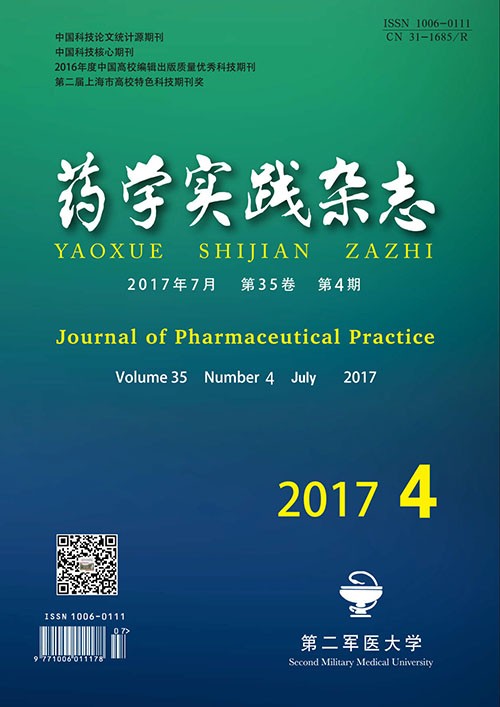ZHOU Chenjian, ZHAO Langhuan, HU Guoxin. Study on pharmacokinetics of pazopanib in rats[J]. Journal of Pharmaceutical Practice and Service, 2017, 35(4): 346-349. doi: 10.3969/j.issn.1006-0111.2017.04.014
| Citation:
|
ZHOU Chenjian, ZHAO Langhuan, HU Guoxin. Study on pharmacokinetics of pazopanib in rats[J]. Journal of Pharmaceutical Practice and Service, 2017, 35(4): 346-349. doi: 10.3969/j.issn.1006-0111.2017.04.014
|
Study on pharmacokinetics of pazopanib in rats
- 1.
Center Hospital of Wenzhou, Wenzhou 235000, China
- 2.
People's Hospital of Wenzhou, Wenzhou 235000, China
- 3.
Medical College of Wenzhou, Wenzhou 235000, China
- Received Date: 2016-12-19
- Rev Recd Date:
2017-02-17
-
Abstract
Objective To develop a UPLC-MS method for the determination of pazopanib in rat plasma, and study the pharmacokinetics of pazopanib in rats. Methods The effective UPLC MS/MS separation of the examined compounds was applied on an Acquity BEH C18 column with a gradient mobile phase system. AB Sciex QTRAP 5500 triple quadruple mass spectrometer equipped with an electrospray ionization (ESI) interface was used for mass spectrometric detection. The MRM transitions of m/z 438.3→357.2 and m/z 285.2→193.1 were used to quantify for pazopanib and ISTD, respectively; 6 rats were given 80 mg/kg pazopanib intragastric administration. Blood samples were collected from the tail vein at different point after administration. The concentration of pazopanib in plasma was detected by the UPLC-MS methods. The pharmacokinetics parameters were analyzed by DAS program. Results Pazopanib and ISTD were eluted at 1.10 and 1.37 min respectively. Excellent liner relationship was obtained from the range of 0.25 μg/ml to 40.00 μg/ml (r=0.999 2). The intra-day RSD were 6.17%, 2.73% and 2.54% and inter-day RSD were 7.56%, 5.98% and 2.84% respectively at three concentrations (0.50, 10.00, 30.00 μg/ml), the recoveries were (78.4±4.8)%, (85.9±3.5)% and (81.1±4.2)% respectively, the Matrix effect were (106.7±5.3) %, (101.3±6.7) % and (97.6±4.4) % respectively at three concentrations (0.50, 10.00, 30.00 μg/ml); 6 rats were given 80 mg/kg pazopanib intra-gastric administration. The main pharmacokinetics parameters of pazopanib were as following: cmax (20.22±1.95) μg/ml,tmax (1.75±0.76) h,t1/2 (7.35±2.31) h,AUC0-t (213.16±39.92) μg·h/L,AUC0-∞ (215.79±39.84) μg·h/L,Vd (4.10±1.78) L/kg,CL (0.38±0.07) L/h. Conclusion The method was simple, rapid, accurately,which could be used to determine the pazopanib concentration in rat plasma and study on its pharmacokinetics. Pazopanib was fitted to the first-order elimination kinetics in rats.
-
References
|
[1]
|
Ranieri G, Mammì M, Donato Di Paola E,et al. Pazopanib a tyrosine kinase inhibitor with strong anti-angiogenetic activity: A new treatment for metastatic soft tissue sarcoma[J]. Crit Rev Oncol Hematol,2014,89(2):322-329. |
|
[2]
|
Hamberg P, Verweij J, Sleijfer S. (Pre-)clinical pharmacology and activity of pazopanib, a novel multikinase angiogenesis inhibitor[J].Oncologist,2010,15(6):539-547. |
|
[3]
|
Motzer RJ,Hutson TE,Cella D, et al. Pazopanib versus sunitinib in metastatic renal-cell carcinoma[J]. N Engl J Med,2013,369(8):722-731. |
|
[4]
|
Welsh SJ,Fife K. Pazopanib for the treatment of renal cell carcinoma[J]. Future Oncol,2015,11(8):1169-1179. |
|
[5]
|
Dziadosz M,Lessig R,Bartels H. HPLC-DAD protein kinase inhibitor analysis in human serum[J].J Chromatogr B Analyt Technol Biomed Life Sci,2012,893-894:77-81. |
|
[6]
|
Minocha M, Khurana V, Mitra AK. Determination of pazopanib (GW-786034) in mouse plasma and brain tissue by liquid chromatography-tandem mass spectrometry (LC/MS-MS)[J]. J Chromatogr B Analyt Technol Biomed Life Sci,2012, 901:85-92. |
-
-
Proportional views

-







 DownLoad:
DownLoad: